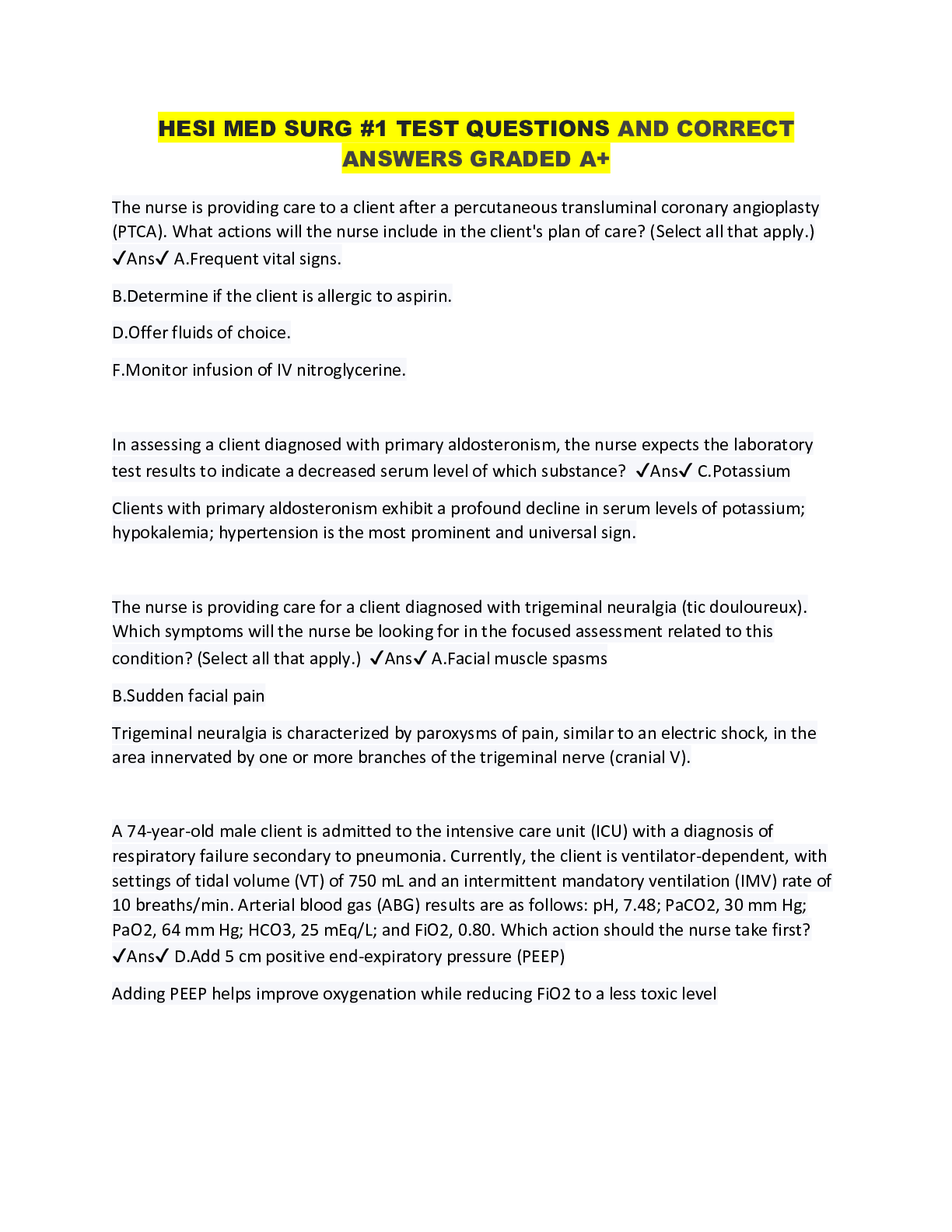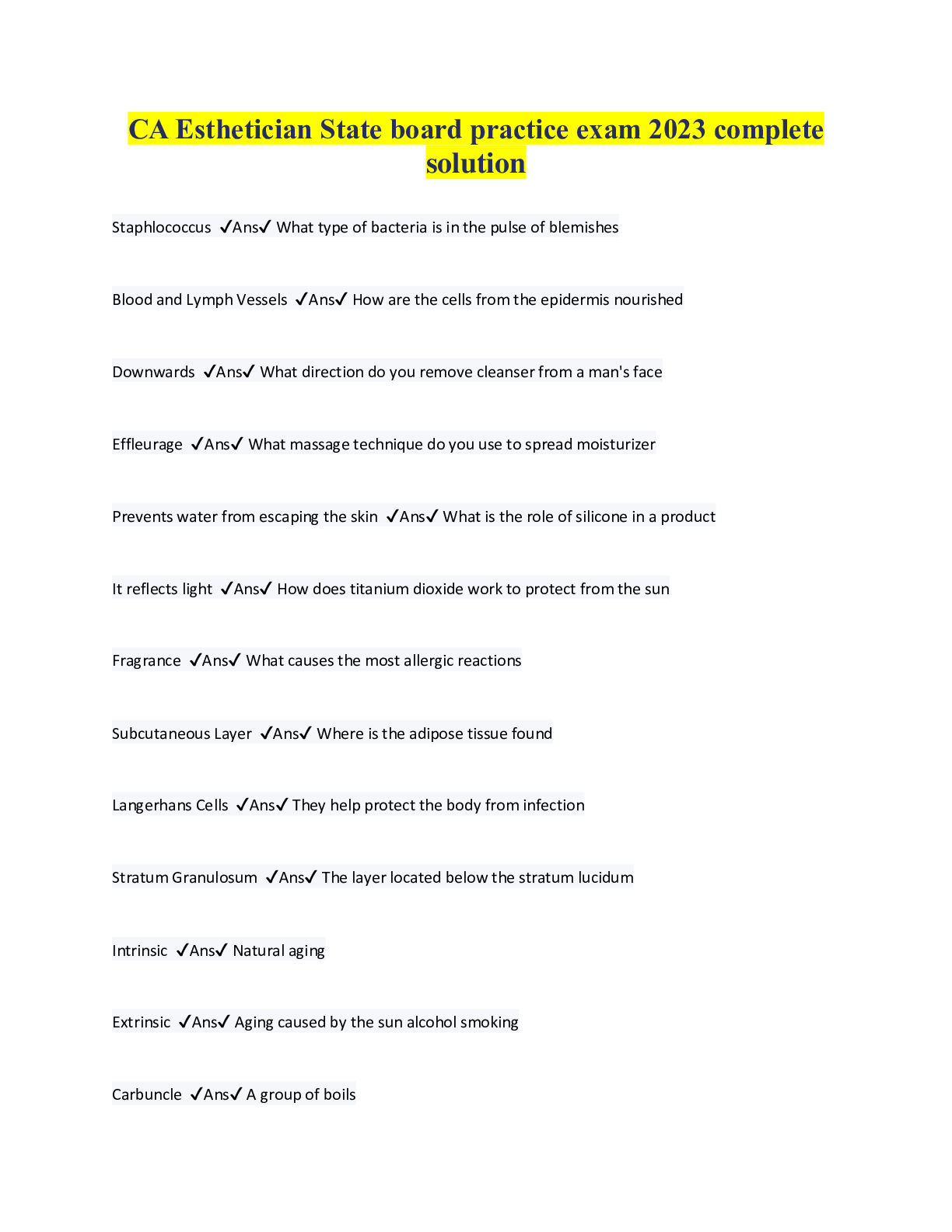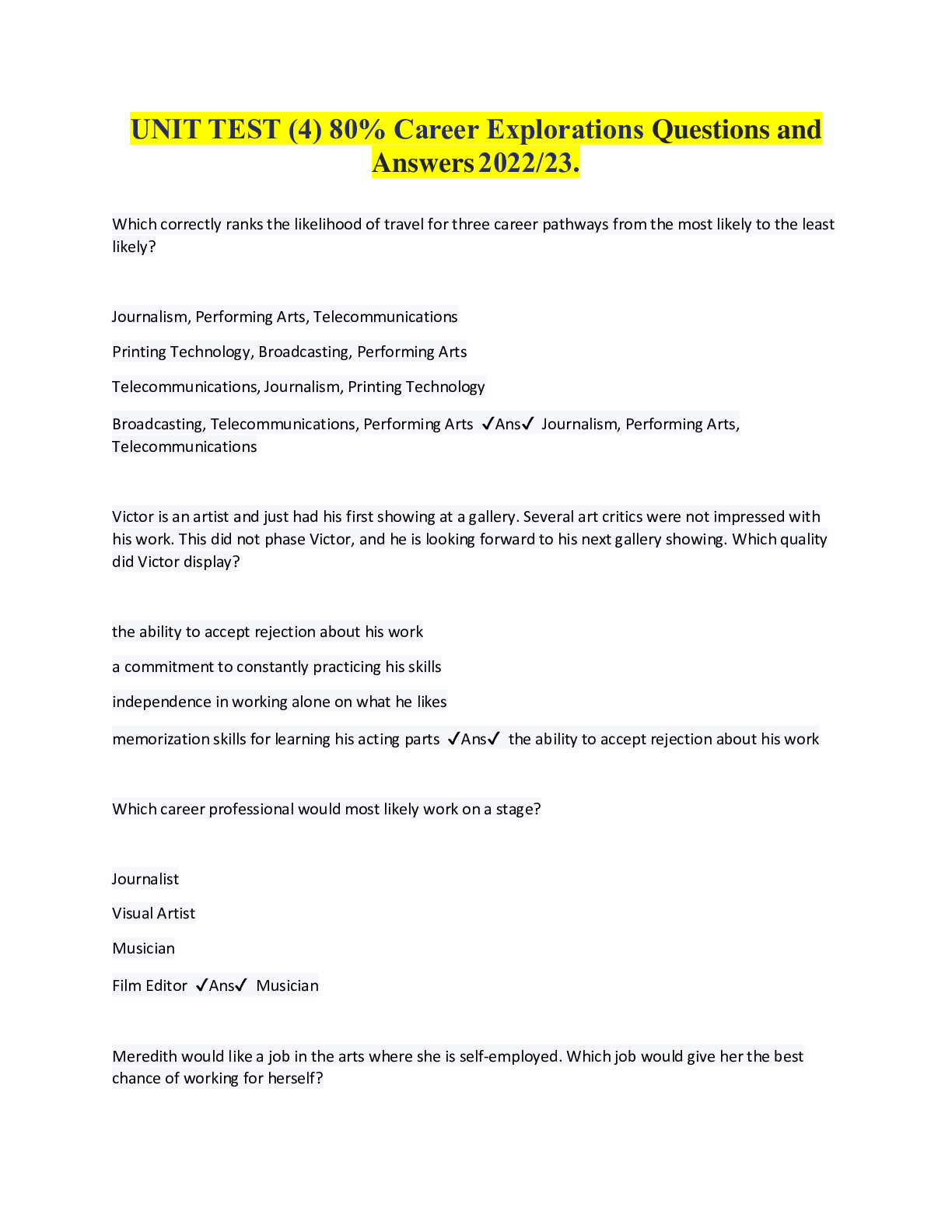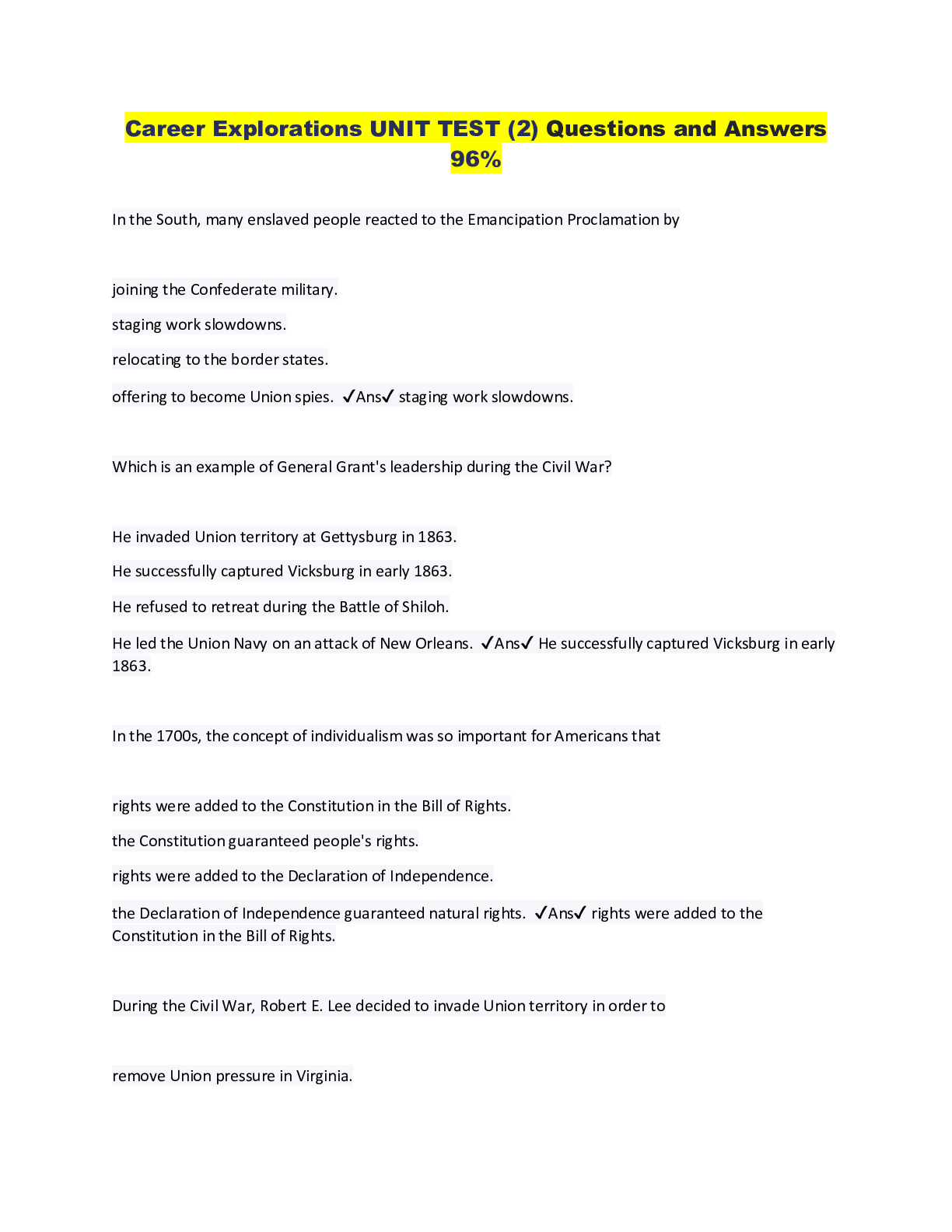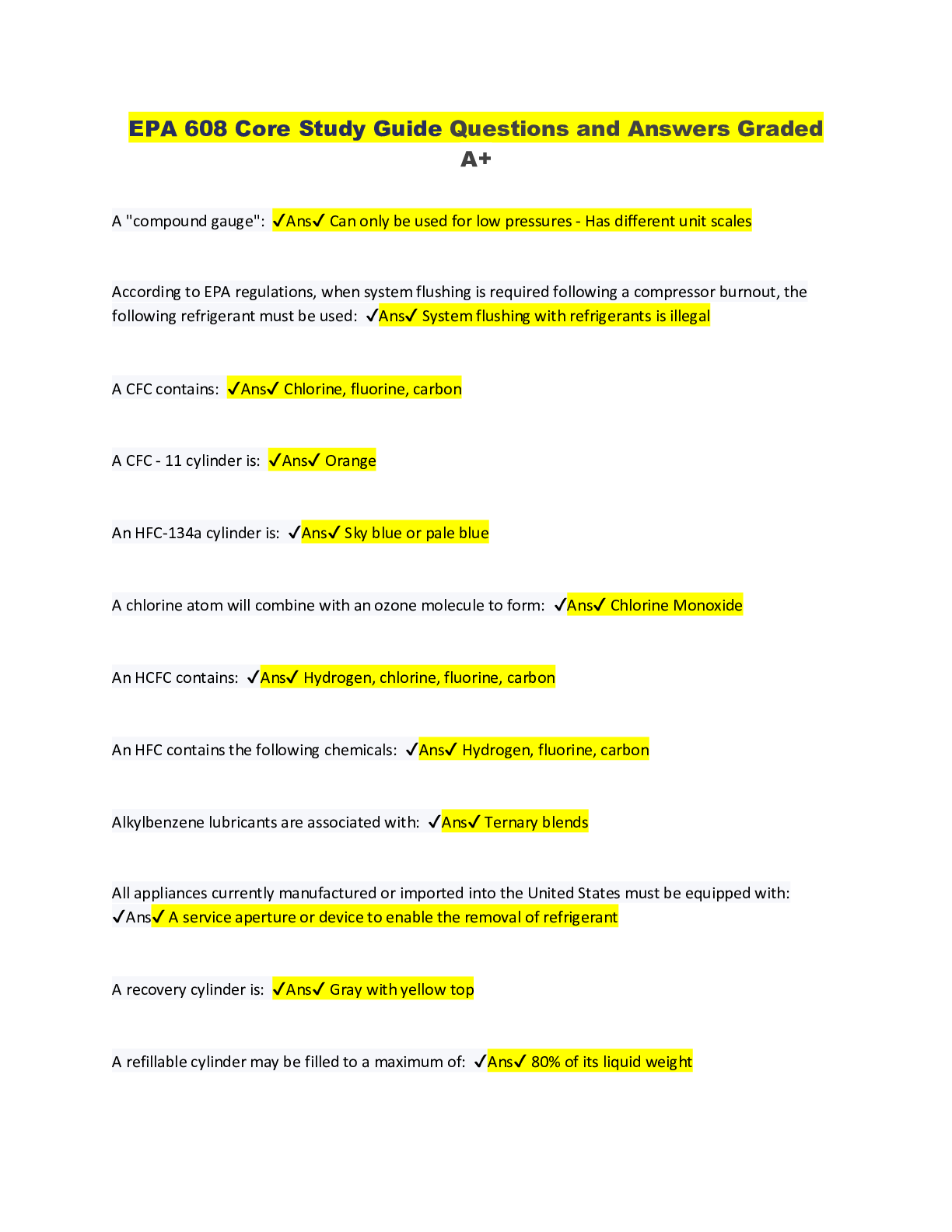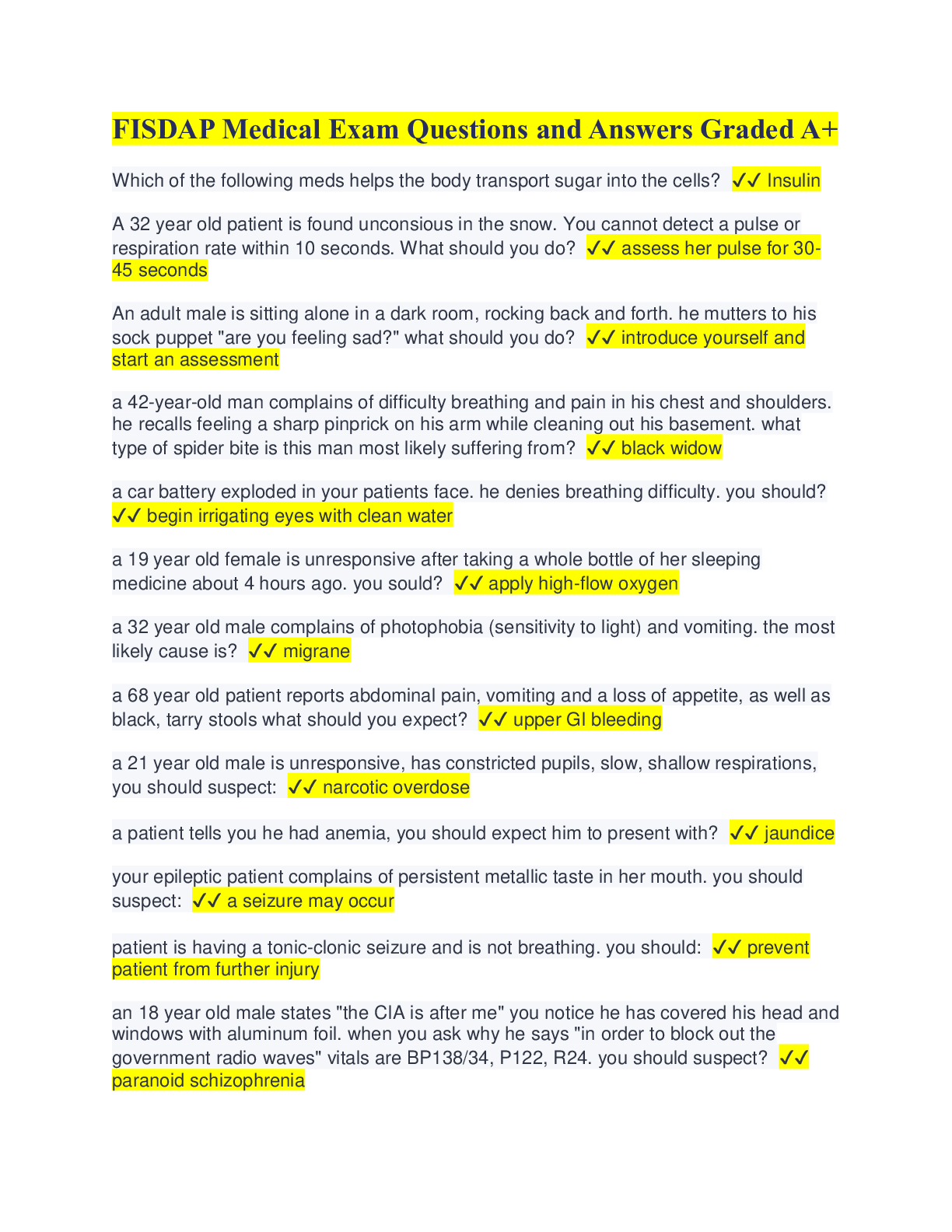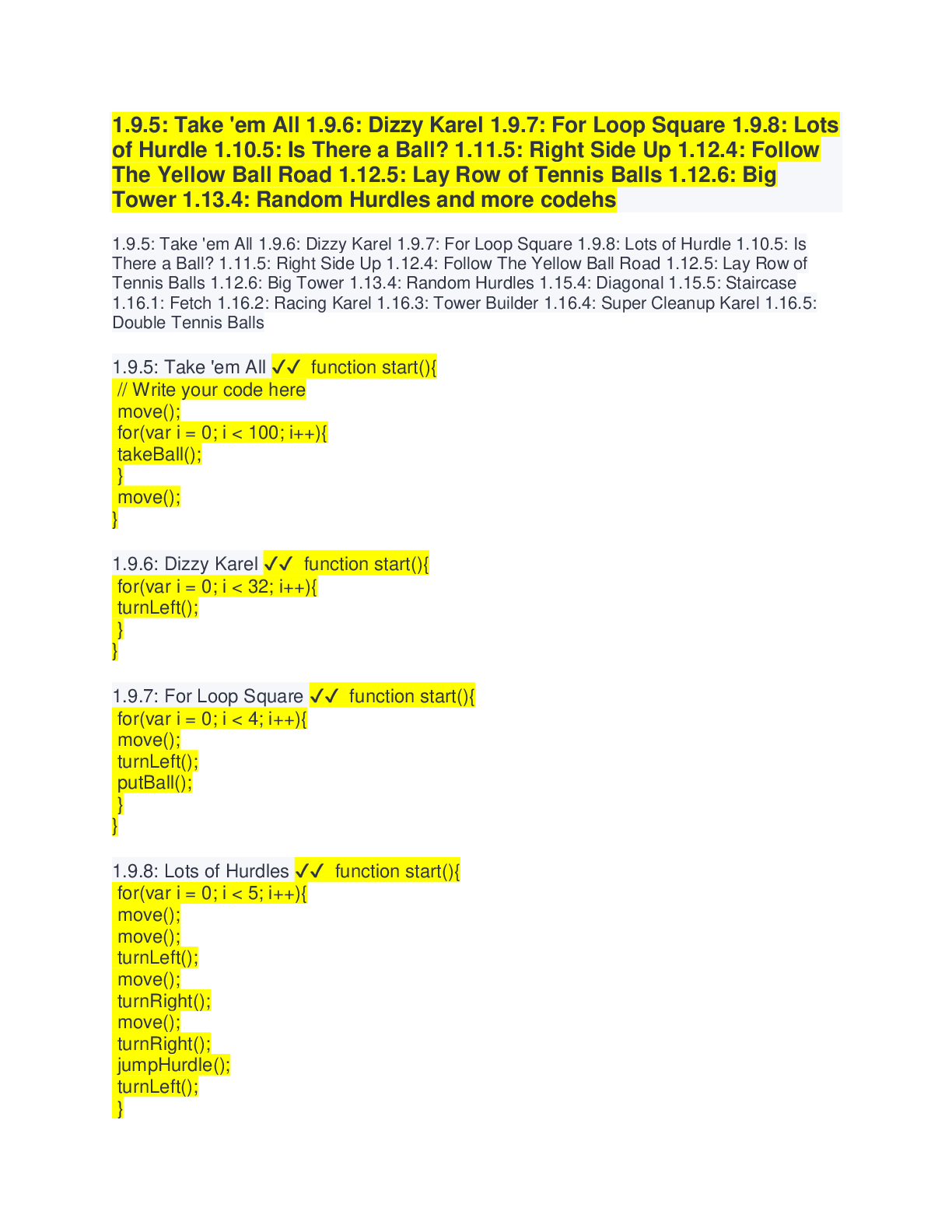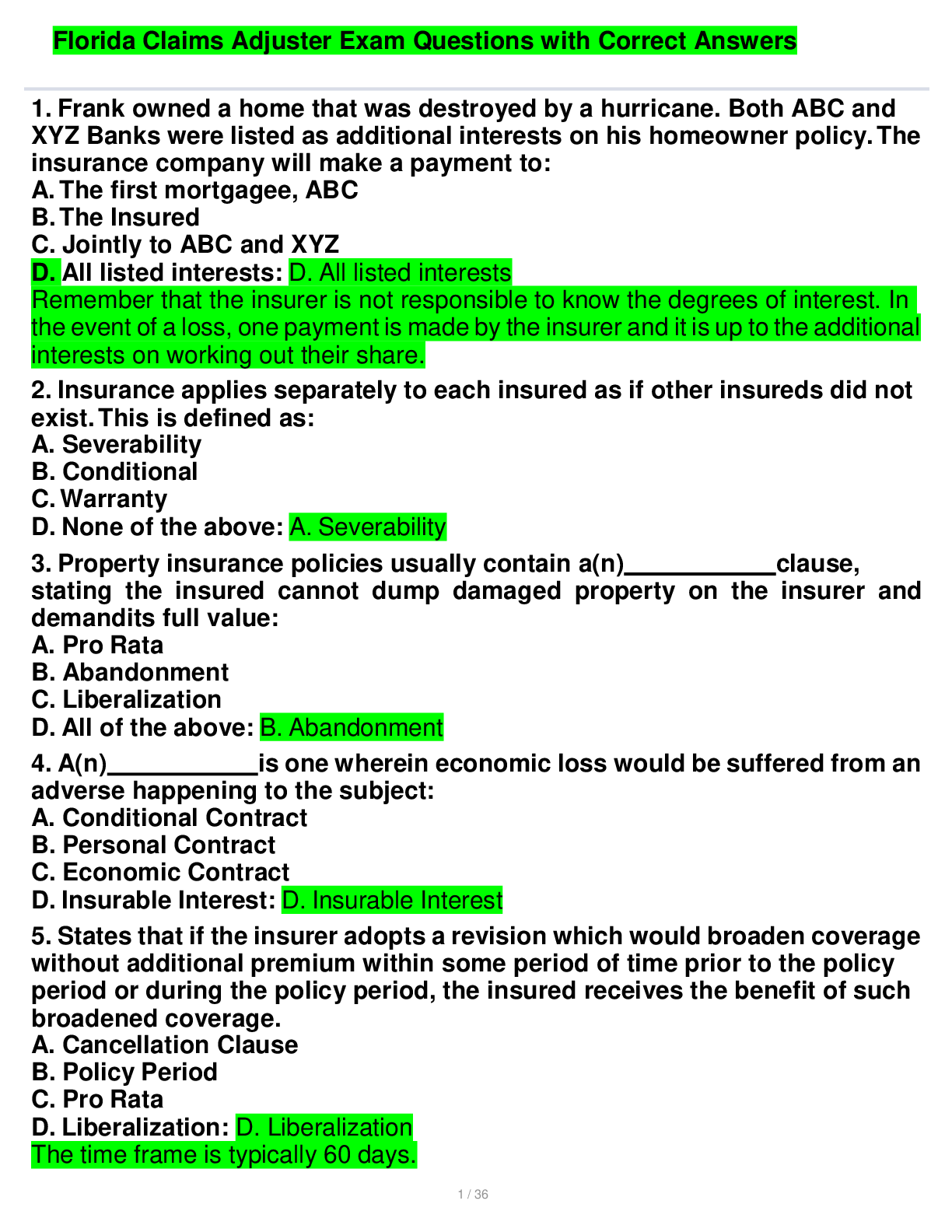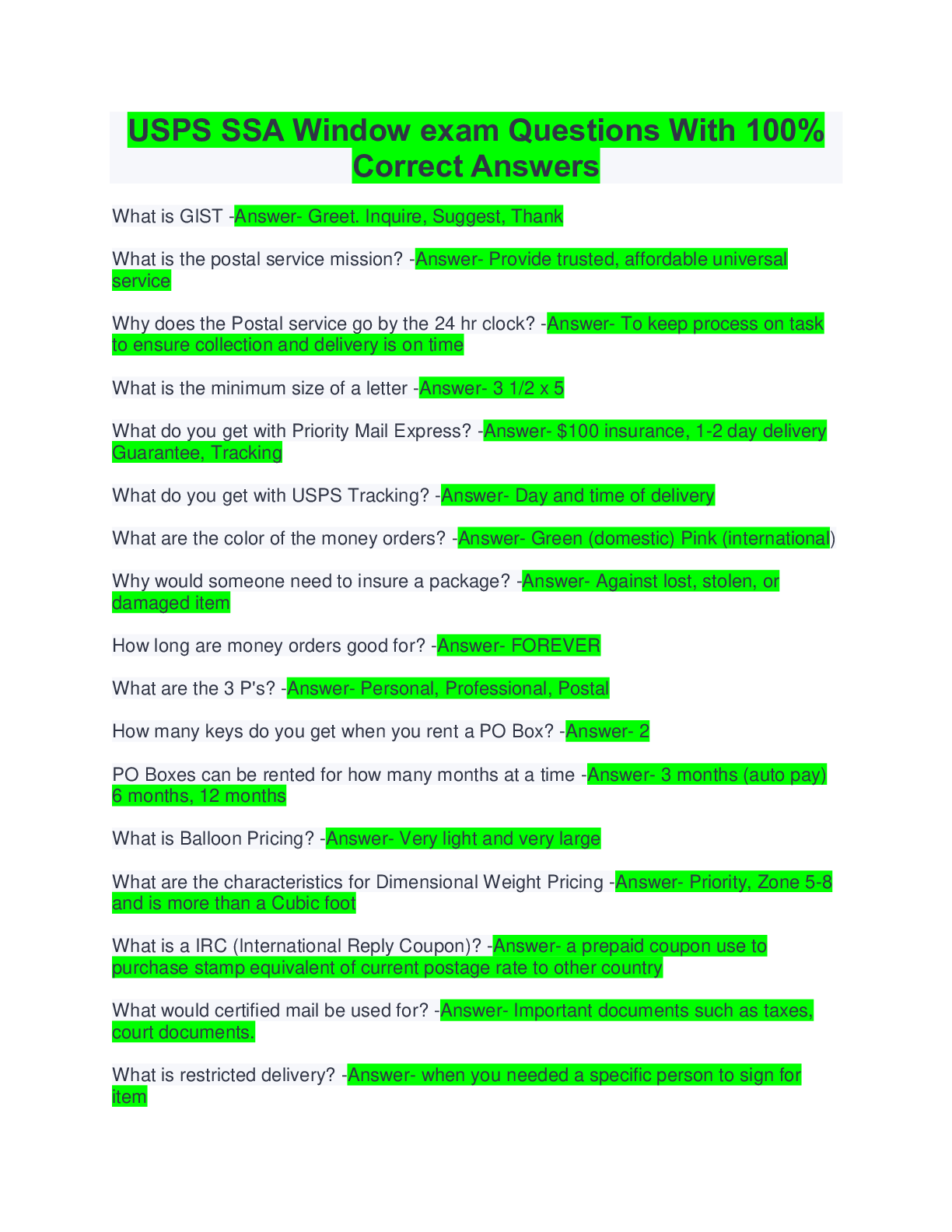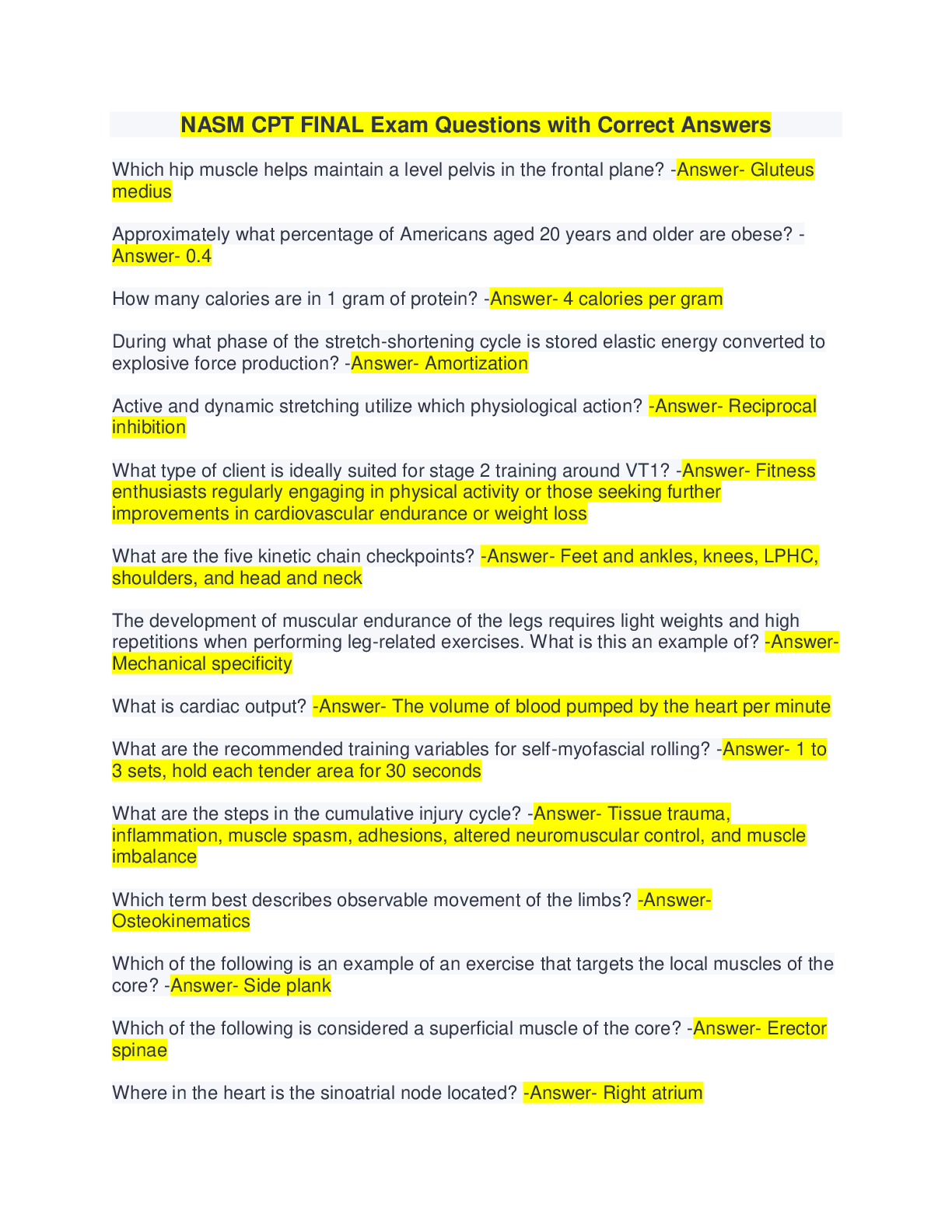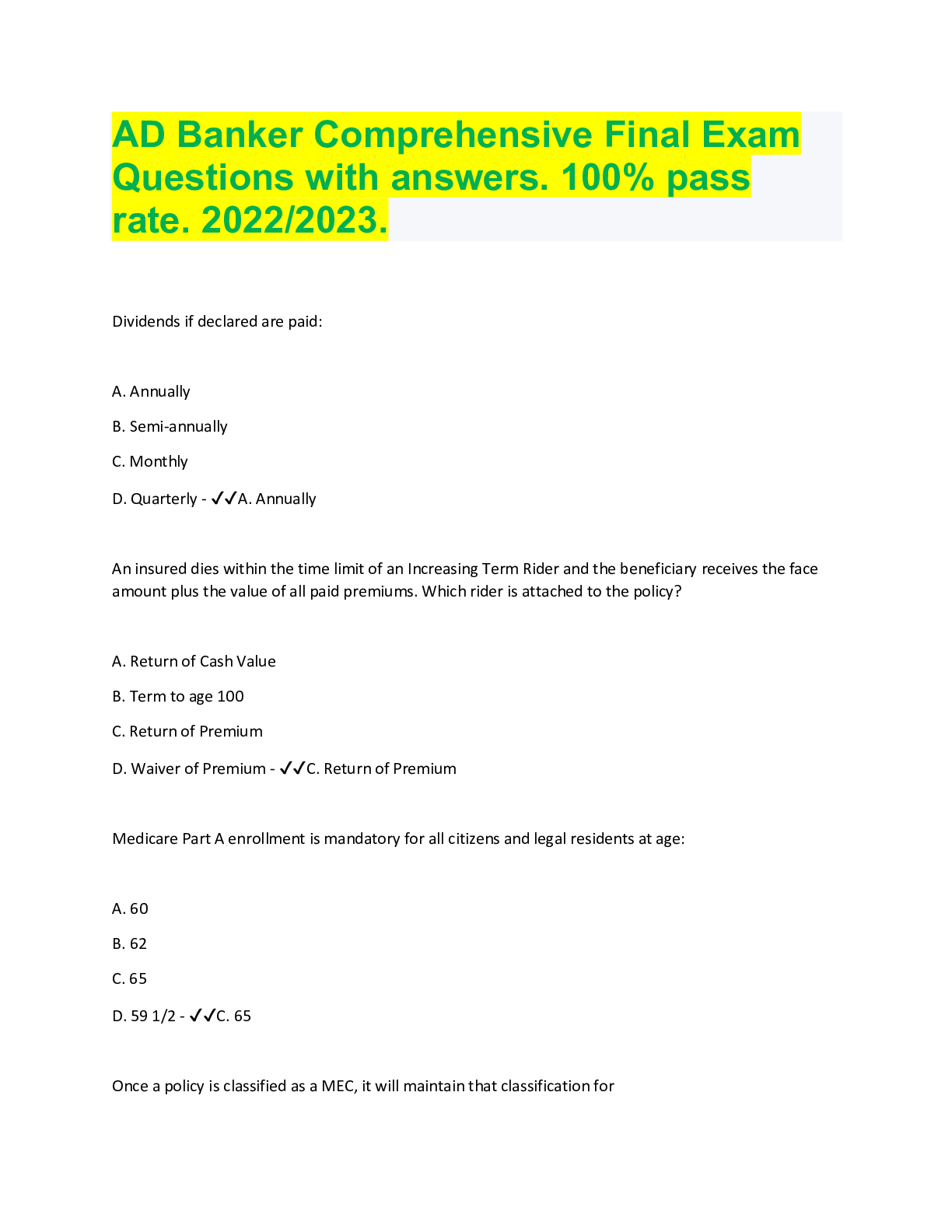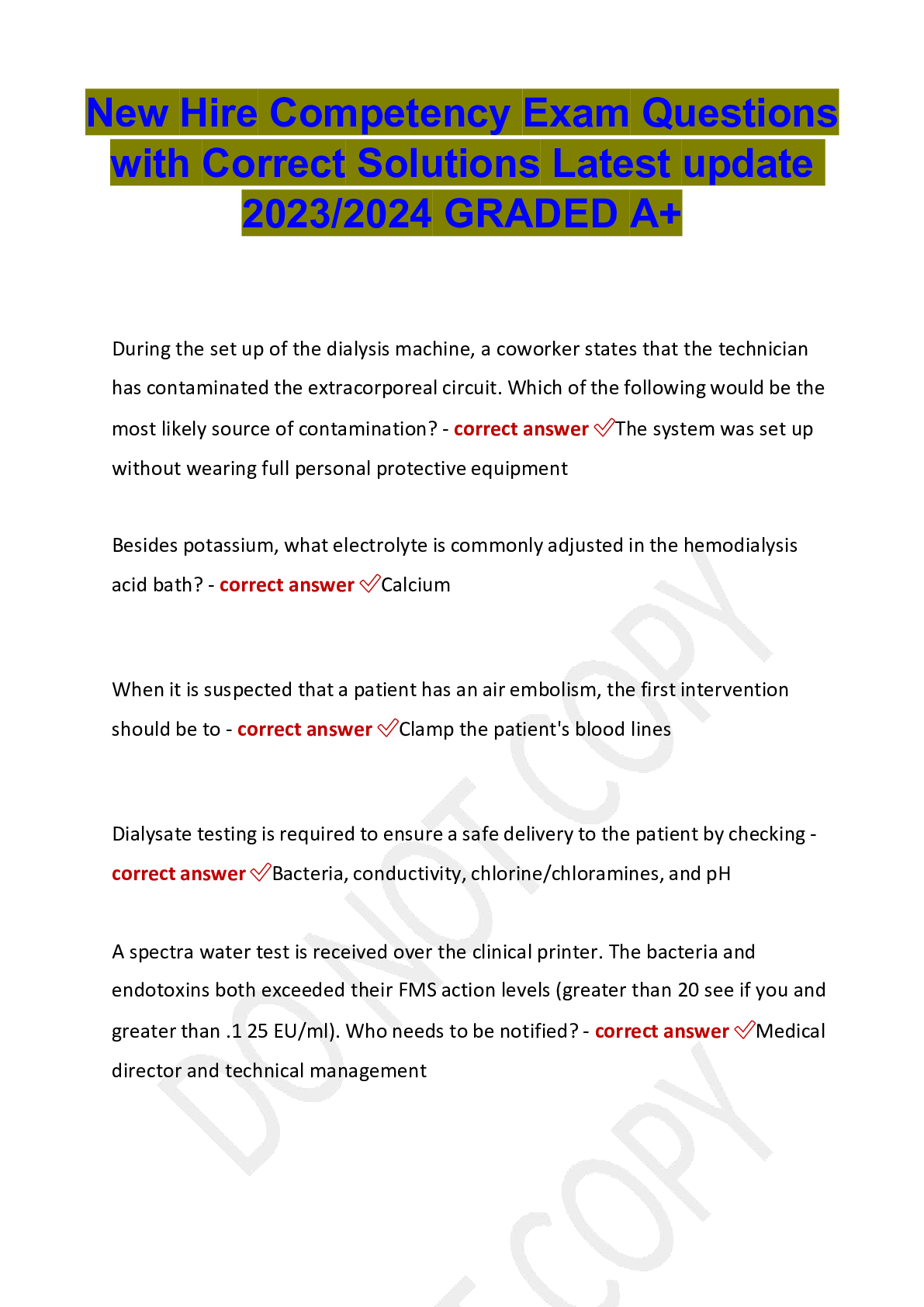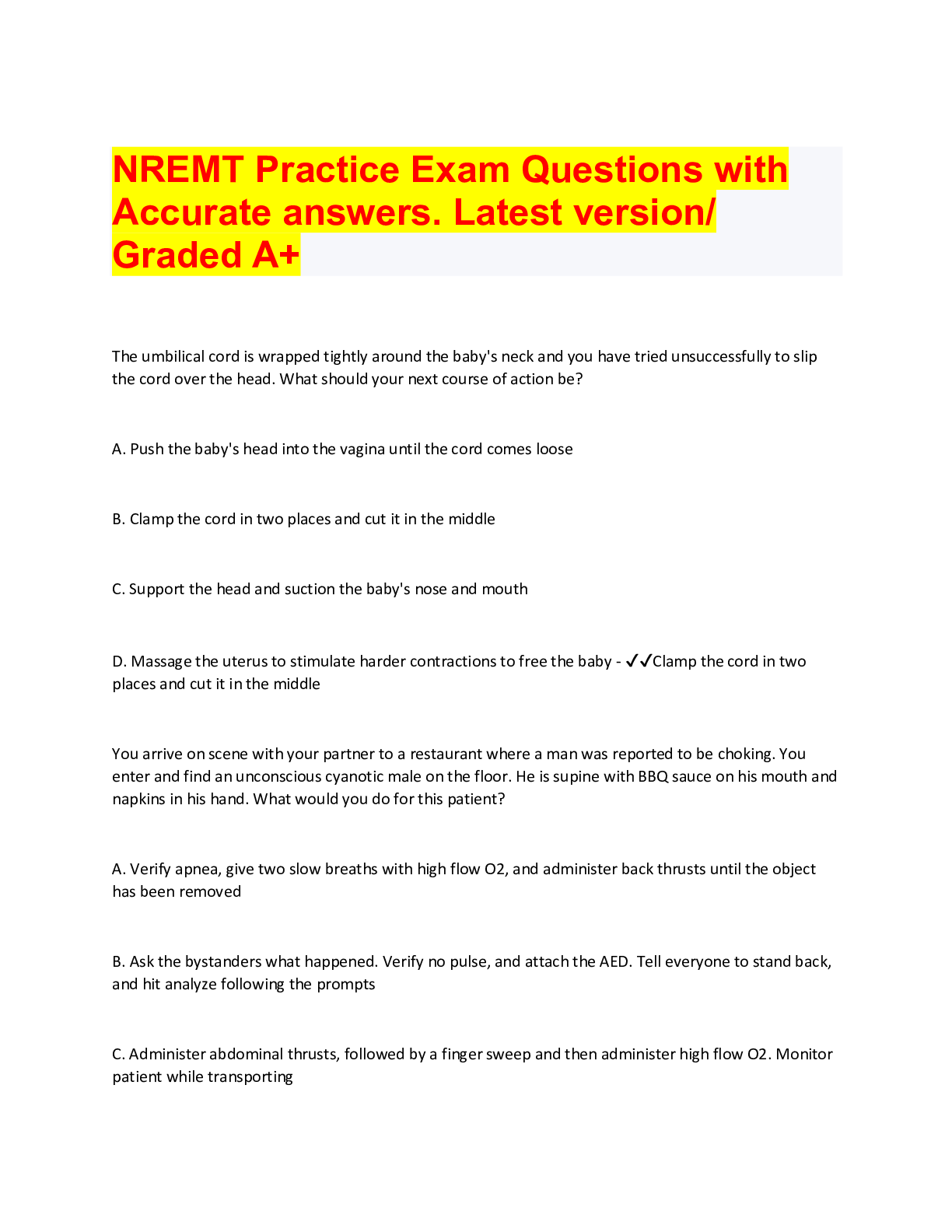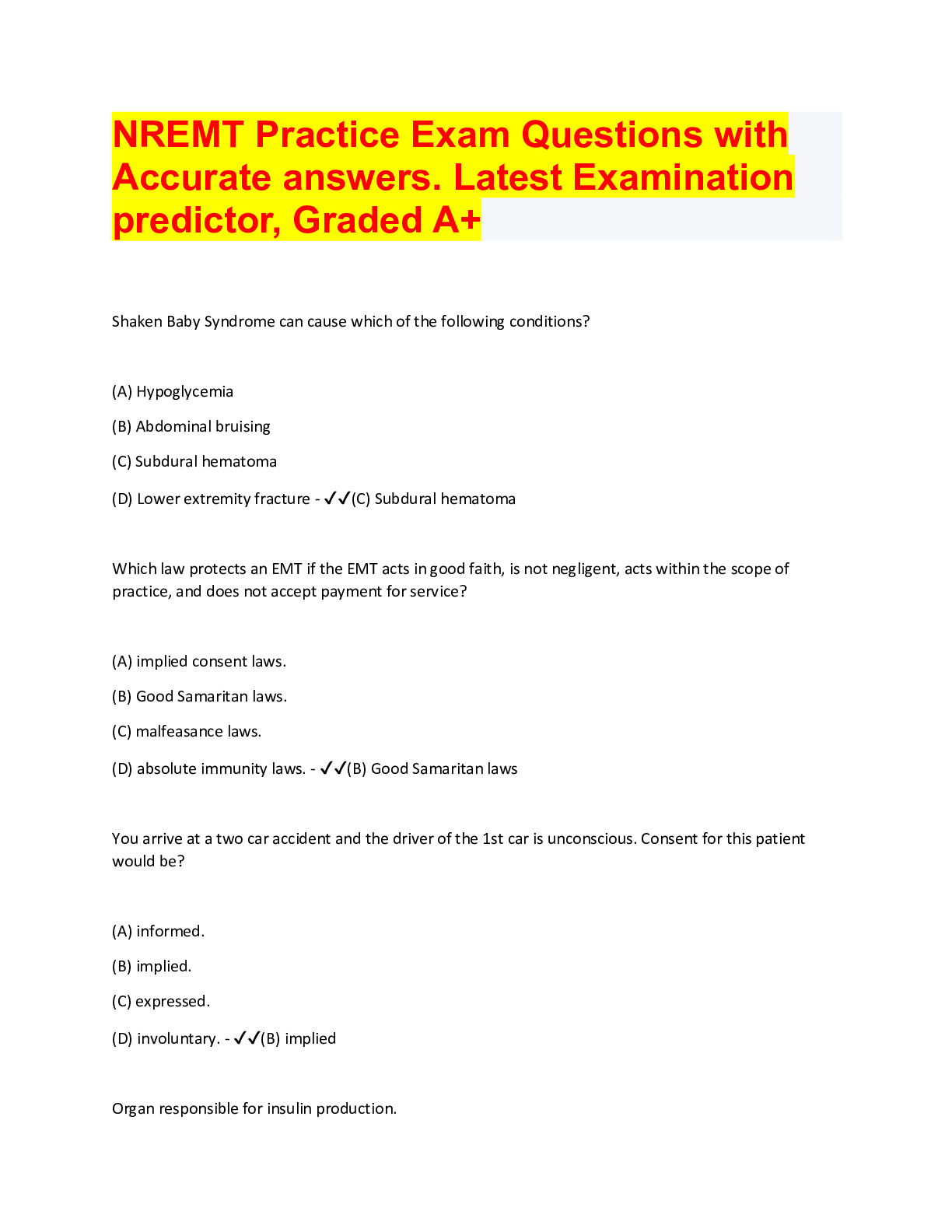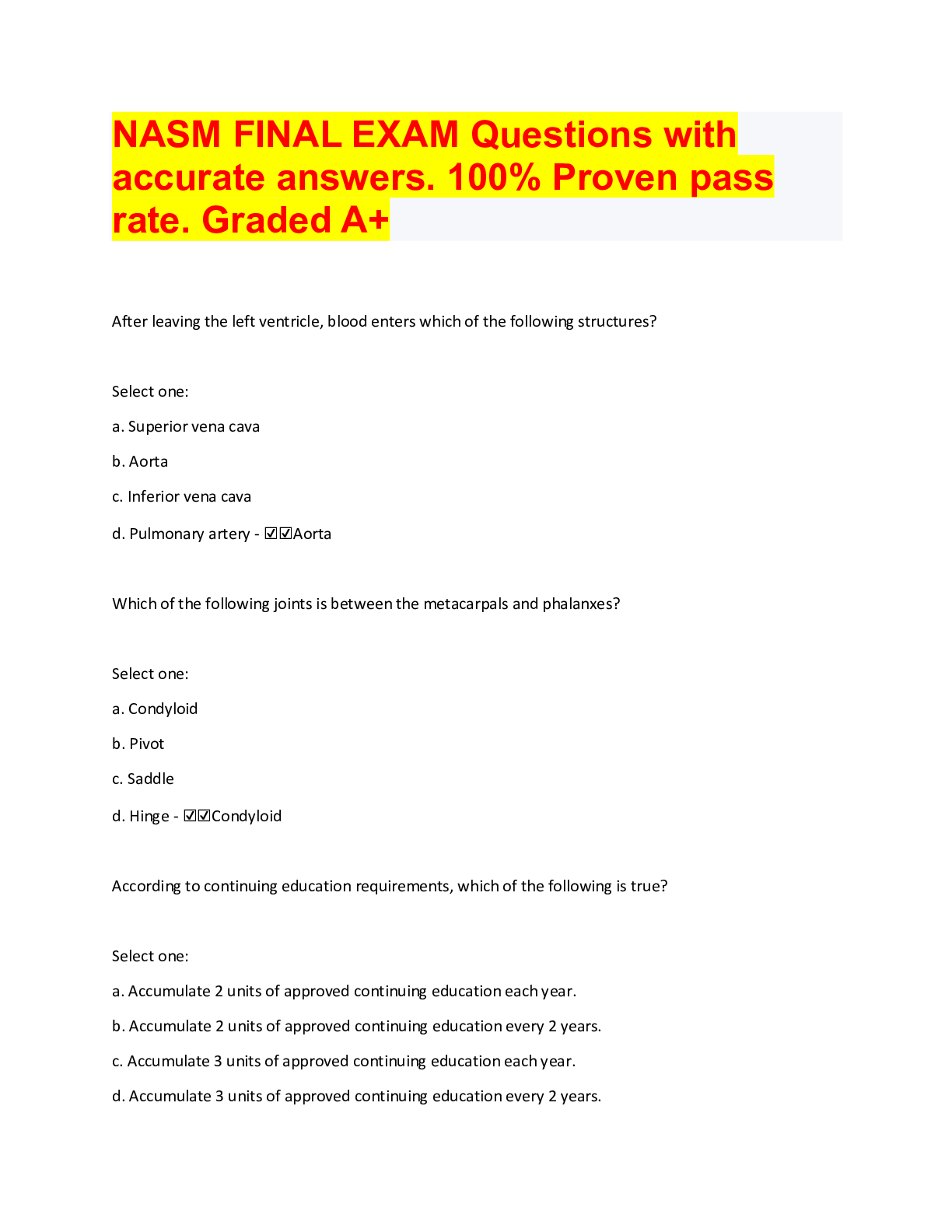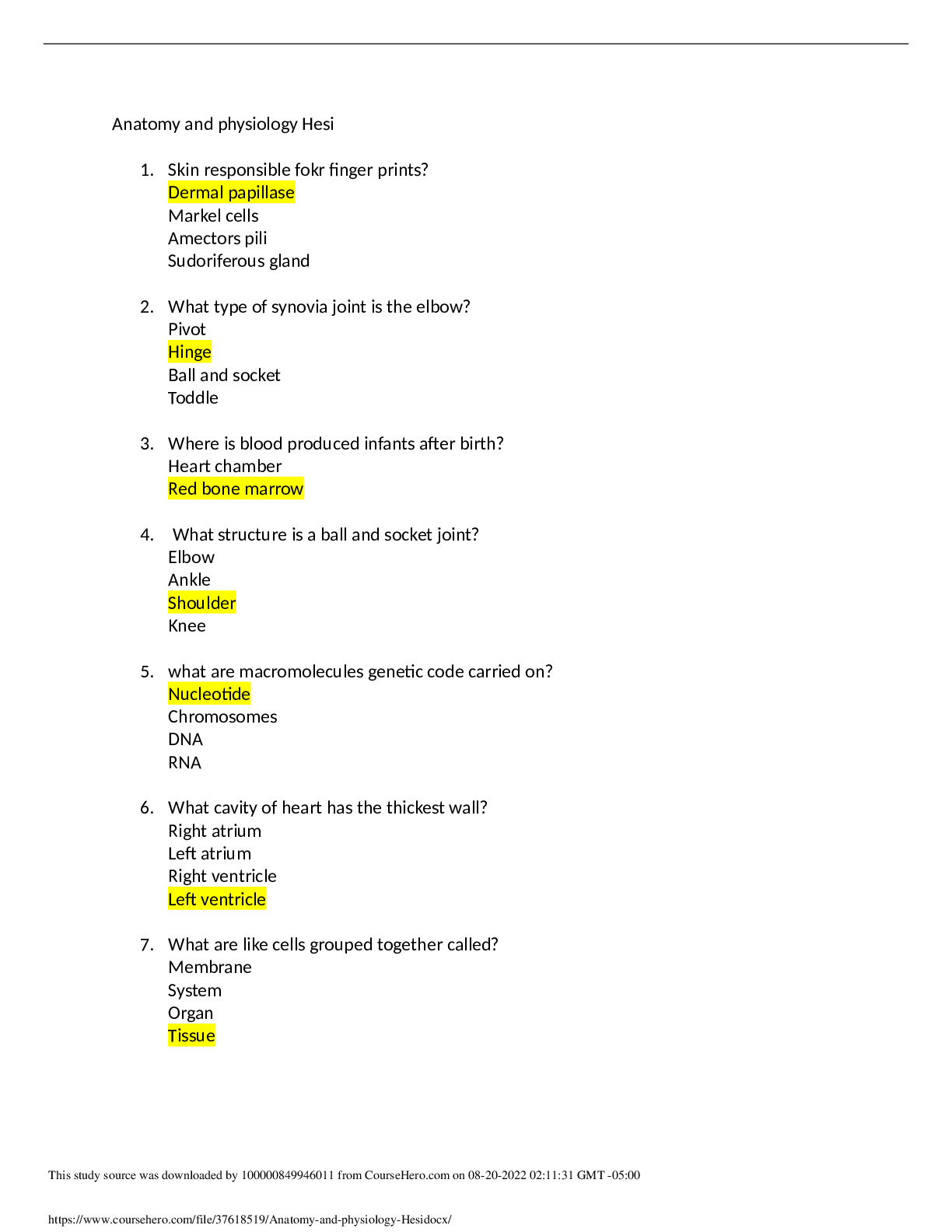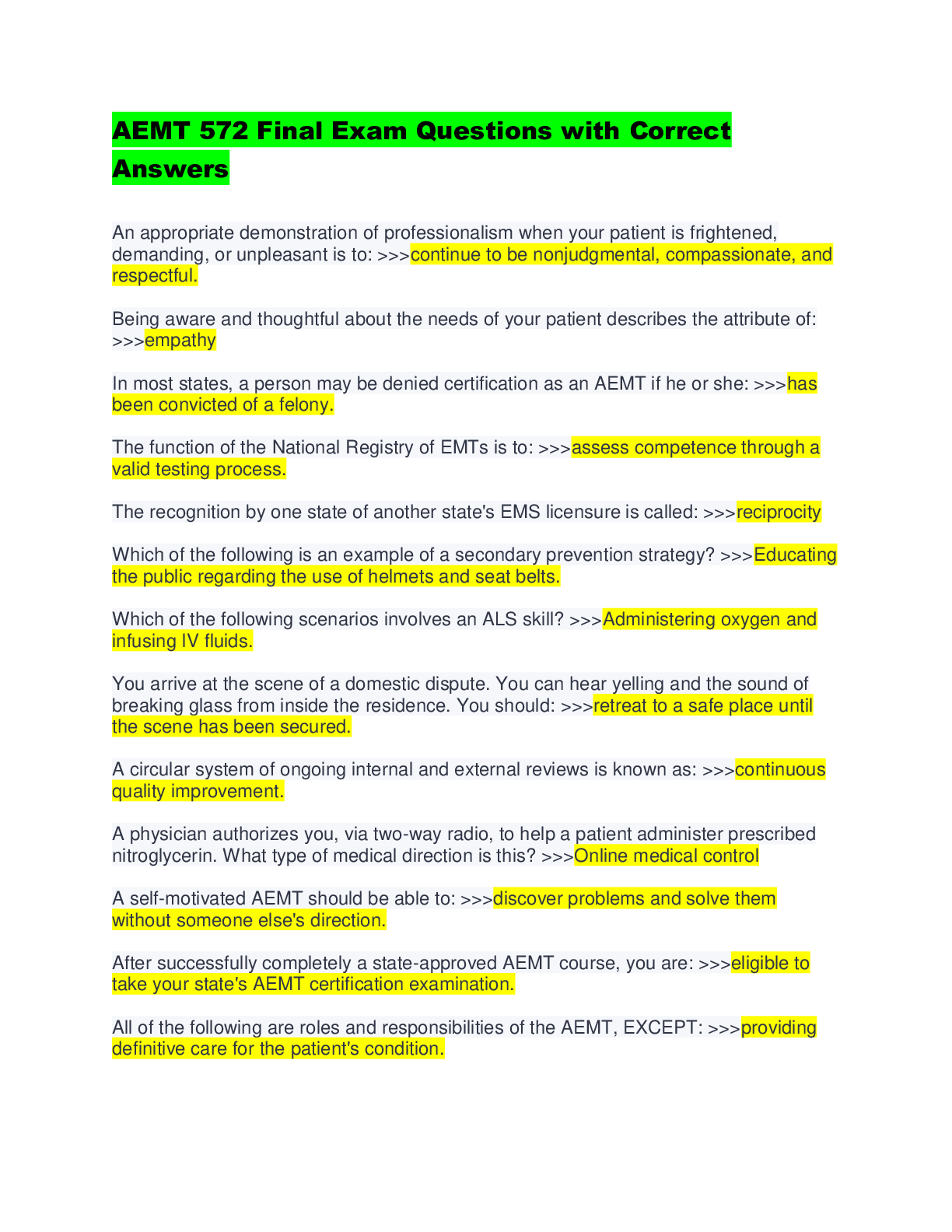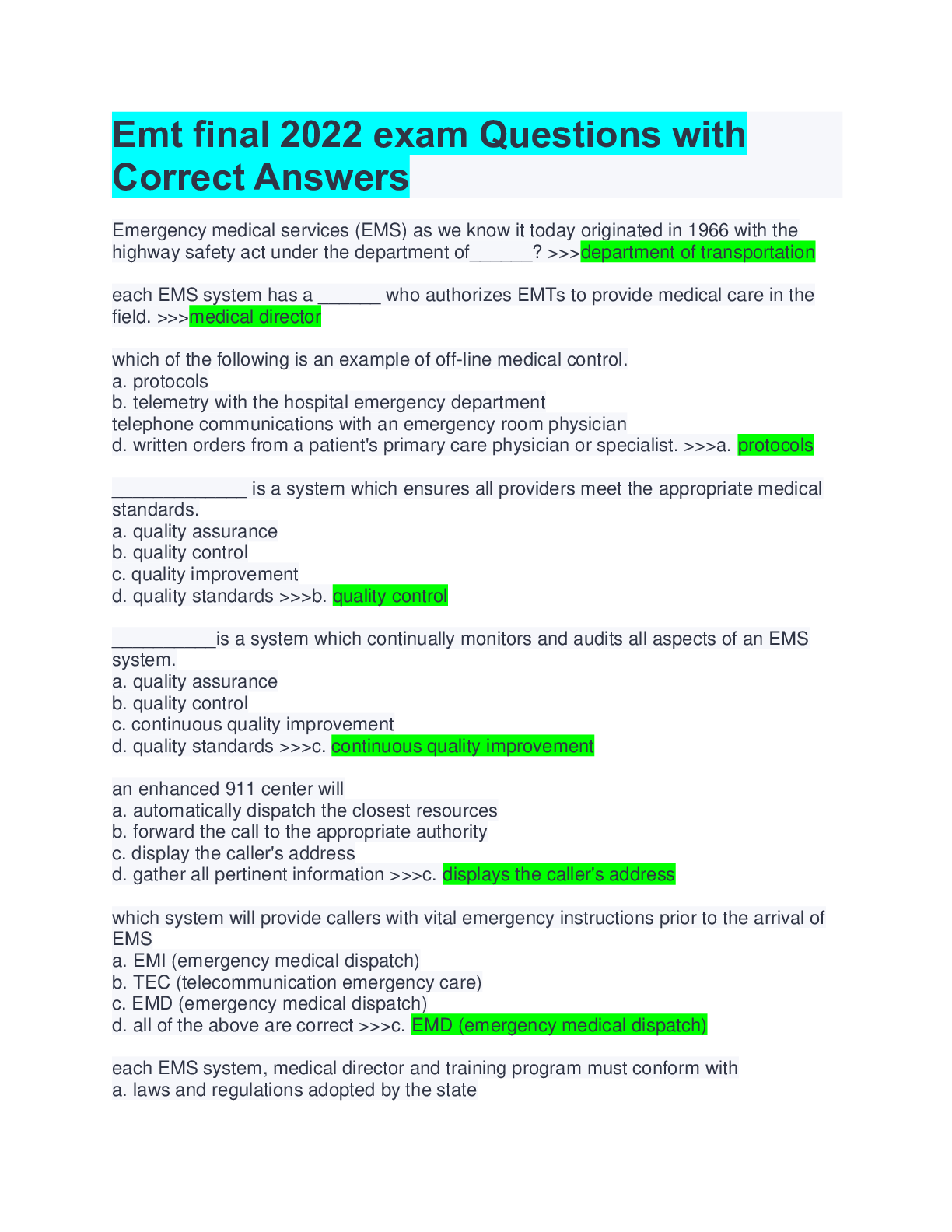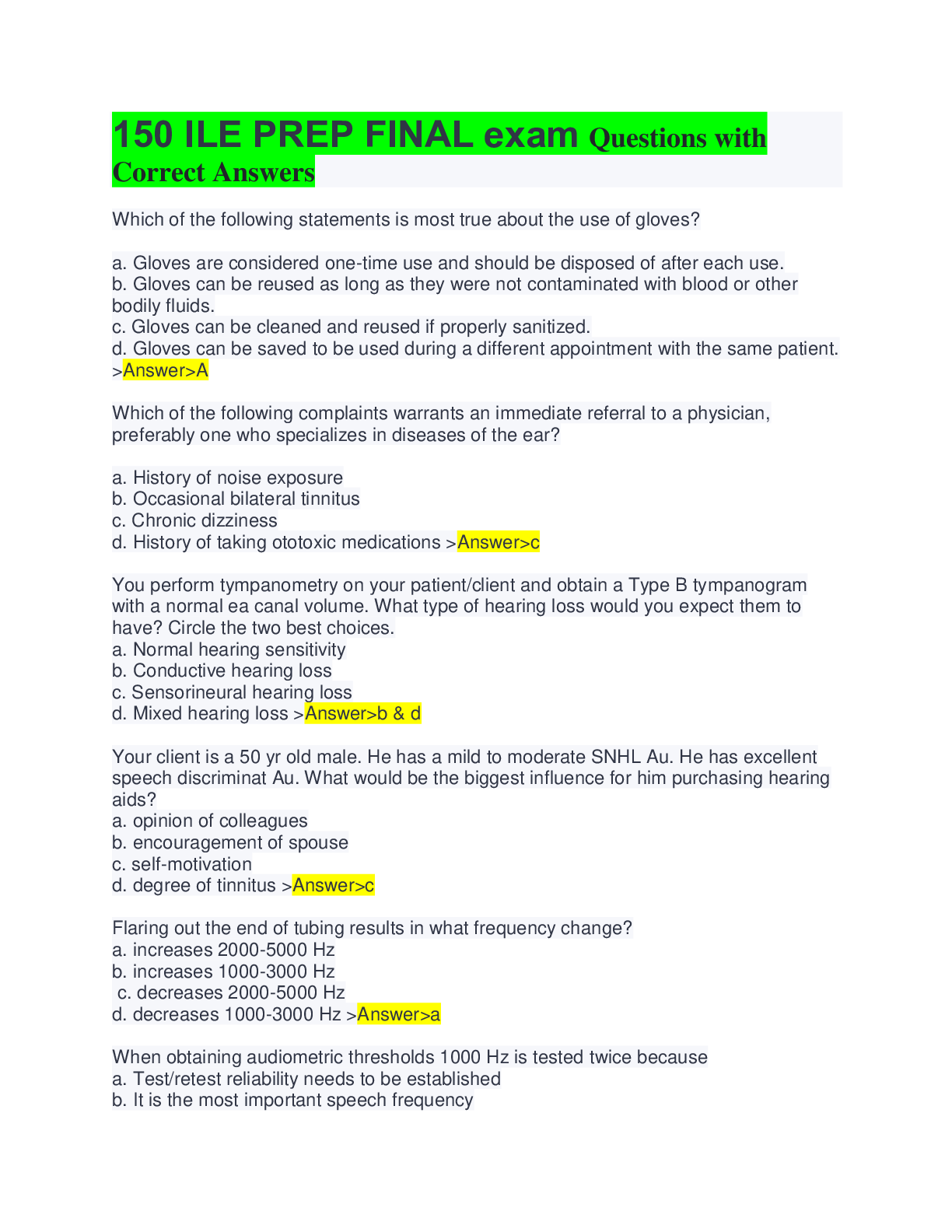Pharmacology > QUESTIONS & ANSWERS > PHARM: Cardio Exam Questions with Correct Answers, Latest Updates (All)
PHARM: Cardio Exam Questions with Correct Answers, Latest Updates
Document Content and Description Below
PHARM: Cardio Exam Questions with Correct Answers, Latest Updates Potassium chloride intravenously is prescribed for a client with hypokalemia. Which actions should the nurse take to plan for prepa... ration and administration of the potassium? Select all that apply. 1. Obtain an intravenous (IV) infusion pump. 2. Monitor urine output during administration. 3. Prepare the medication for bolus administration. 4. Monitor the IV site for signs of infiltration or phlebitis. 5. Ensure that the medication is diluted in the appropriate volume of fluid. 6. Ensure that the bag is labeled so that it reads the volume of potassium in the solution.✔✔ 1. Obtain an intravenous (IV) infusion pump. 2. Monitor urine output during administration. 4. Monitor the IV site for signs of infiltration or phlebitis. 5. Ensure that the medication is diluted in the appropriate volume of fluid. 6. Ensure that the bag is labeled so that it reads the volume of potassium in the solution. Rationale: Potassium chloride administered intravenously must always be diluted in IV fluid and infused via an infusion pump. Potassium chloride is never given by bolus (IV push). Giving potassium chloride by IV push can result in cardiac arrest. The nurse should ensure that the potassium is diluted in the appropriate amount of diluent or fluid. The IV bag containing the potassium chloride should always be labeled with the volume of potassium it contains. The IV site is monitored closely because potassium chloride is irritating to the veins and there is risk of phlebitis. In addition, the nurse should monitor for infiltration. The nurse monitors urinary output during administration and contacts the health care provider if the urinary output is less than 30 mL/hour. A client with atrial fibrillation is receiving a continuous heparin infusion at 1000 units/hour. The nurse determines that the client is receiving the therapeutic effect based on which results? 1. Prothrombin time of 12.5 seconds 2. Activated partial thromboplastin time of 60 seconds 3. Activated partial thromboplastin time of 28 seconds 4. Activated partial thromboplastin time longer than 120 seconds✔✔ 2. Activated partial thromboplastin time of 60 seconds Rationale: Common laboratory ranges for activated partial thromboplastin time (aPTT) are 30 to 40 seconds. Because the aPTT should be 1.5 to 2.5 times the normal value, the client'saPTT would be considered therapeutic if it was 60 seconds. Prothrombin time assesses response to warfarin therapy. The nurse provides discharge instructions to a client who is taking warfarin sodium. Which statement, by the client, reflects the need for further teaching? 1. "I will avoid alcohol consumption." 2. "I will take my pills every day at the same time." 3. "I have already called my family to pick up a MedicAlert bracelet." 4. "I will take coated aspirin for my headaches because it will coat my stomach."✔✔ 4. "I will take coated aspirin for my headaches because it will coat my stomach." Rationale: Aspirin-containing products need to be avoided when a client is taking this medication. Alcohol consumption should be avoided by a client taking warfarin sodium. Taking the prescribed medication at the same time each day increases client compliance. The MedicAlert bracelet provides health care personnel with emergency information. A client who is receiving digoxin daily has a serum potassium level of 3 mEq/L (3 mmol/L) and is complaining of anorexia. The health care provider prescribes a serum digoxin level to be done. The nurse checks the results and should expect to note which level that is outside of the therapeutic range? 1. 0.3 ng/mL 2. 0.5 ng/mL 3. 0.8 ng/mL 4. 1.0 ng/mL✔✔ 4. 1.0 ng/mL Rationale: The optimal therapeutic range for digoxin is 0.5 to 0.8 ng/mL. If the client is experiencing symptoms such as anorexia and is experiencing hypokalemia as evidenced by a low potassium level, digoxin toxicity is a concern. Therefore, option 4 is correct because it is outside of the therapeutic level and an elevated level. A client is being treated with procainamide for a cardiac dysrhythmia. Following intravenous administration of the medication, the client complains of dizziness. What intervention should the nurse take first? 1. Measure the heart rate on the rhythm strip. 2. Administer prescribed nitroglycerin tablets. 3. Obtain a 12-lead electrocardiogram immediately. 4. Auscultate the client's apical pulse and obtain a blood pressure.✔✔ 4. Auscultate the client's apical pulse and obtain a blood pressure. Rationale:Signs of toxicity from procainamide include confusion, dizziness, drowsiness, decreased urination, nausea, vomiting, and tachydysrhythmias. If the client complains of dizziness, the nurse should assess the vital signs first. Although measuring the heart rate on the rhythm strip and obtaining a 12-lead electrocardiogram may be interventions, these would be done after the vital signs are taken. Nitroglycerin is a vasodilator and will lower the blood pressure. The nurse is monitoring a client who is taking propranolol. Which assessment finding indicates a potential adverse complication associated with this medication? 1. The development of complaints of insomnia 2. The development of audible expiratory wheezes 3. A baseline blood pressure of 150/80 mm Hg followed by a blood pressure of 138/72 mm Hg after 2 doses of the medication 4. A baseline resting heart rate of 88 beats/minute followed by a resting heart rate of 72 beats/minute after 2 doses of the medication✔✔ 2. The development of audible expiratory wheezes Rationale: Audible expiratory wheezes may indicate a serious adverse reaction, bronchospasm. Beta blockers may induce this reaction, particularly in clients with chronic obstructive pulmonary disease or asthma. Normal decreases in blood pressure and heart rate are expected. Insomnia is a frequent mild side effect and should be monitored. [Show More]
Last updated: 1 year ago
Preview 1 out of 44 pages
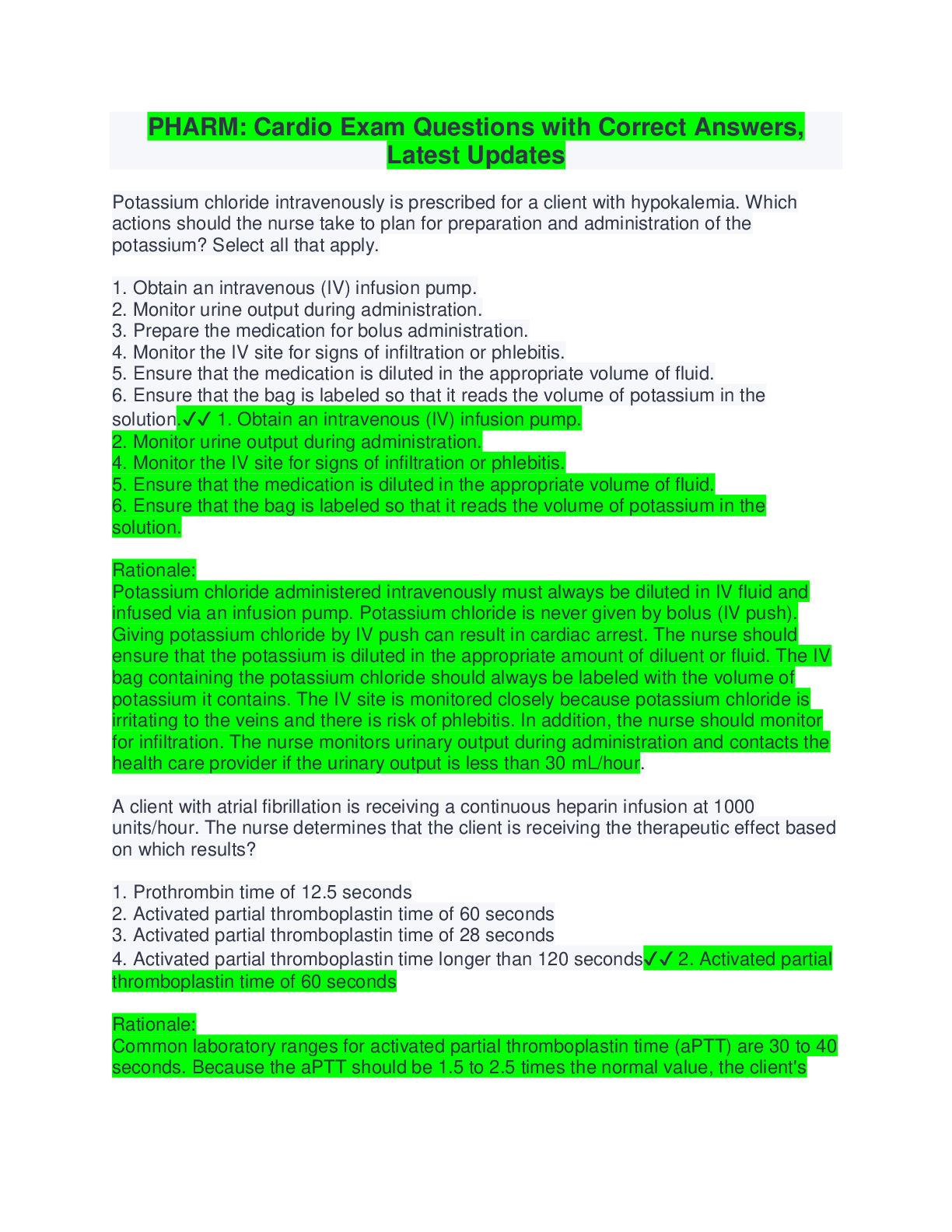
Reviews( 0 )
Document information
Connected school, study & course
About the document
Uploaded On
Dec 06, 2022
Number of pages
44
Written in
Additional information
This document has been written for:
Uploaded
Dec 06, 2022
Downloads
0
Views
251

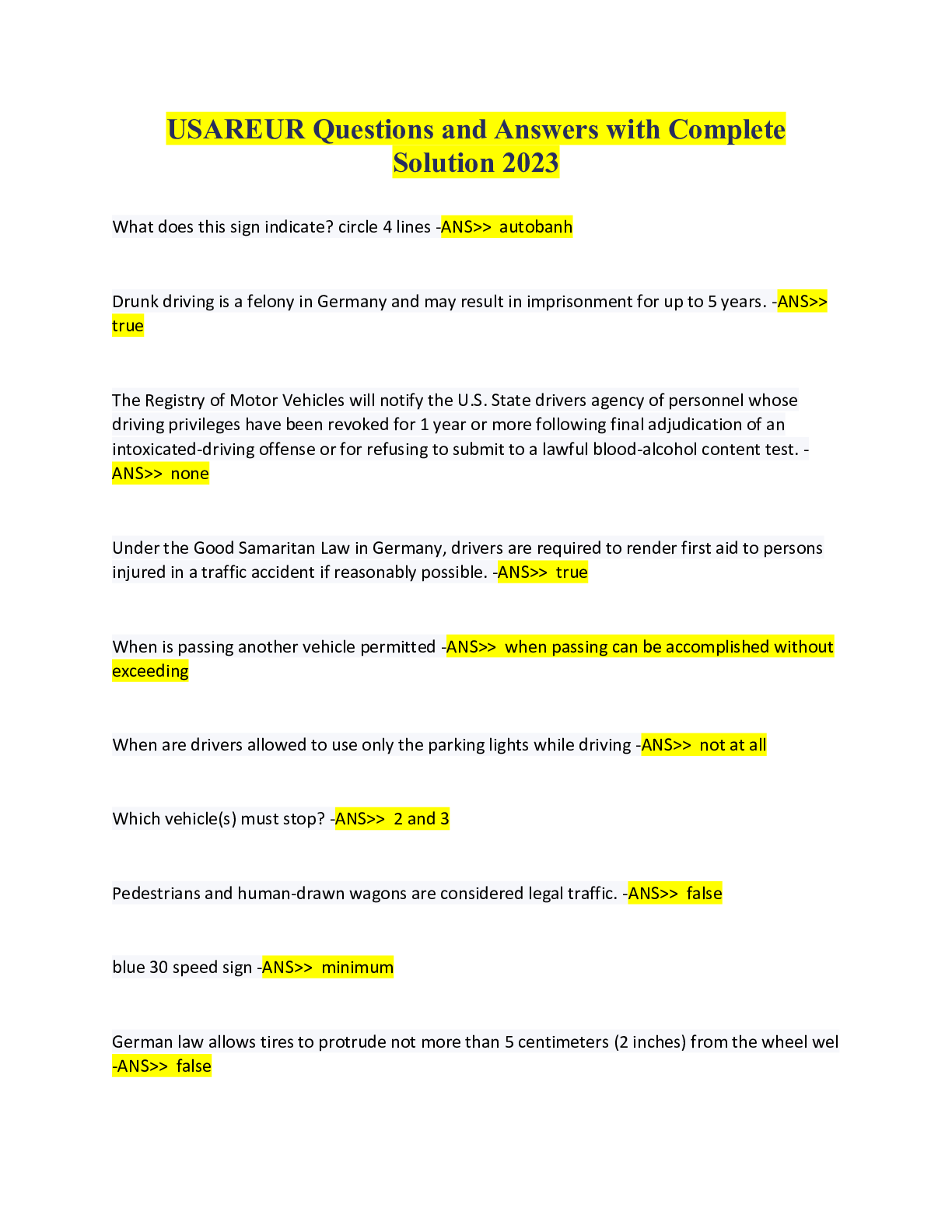

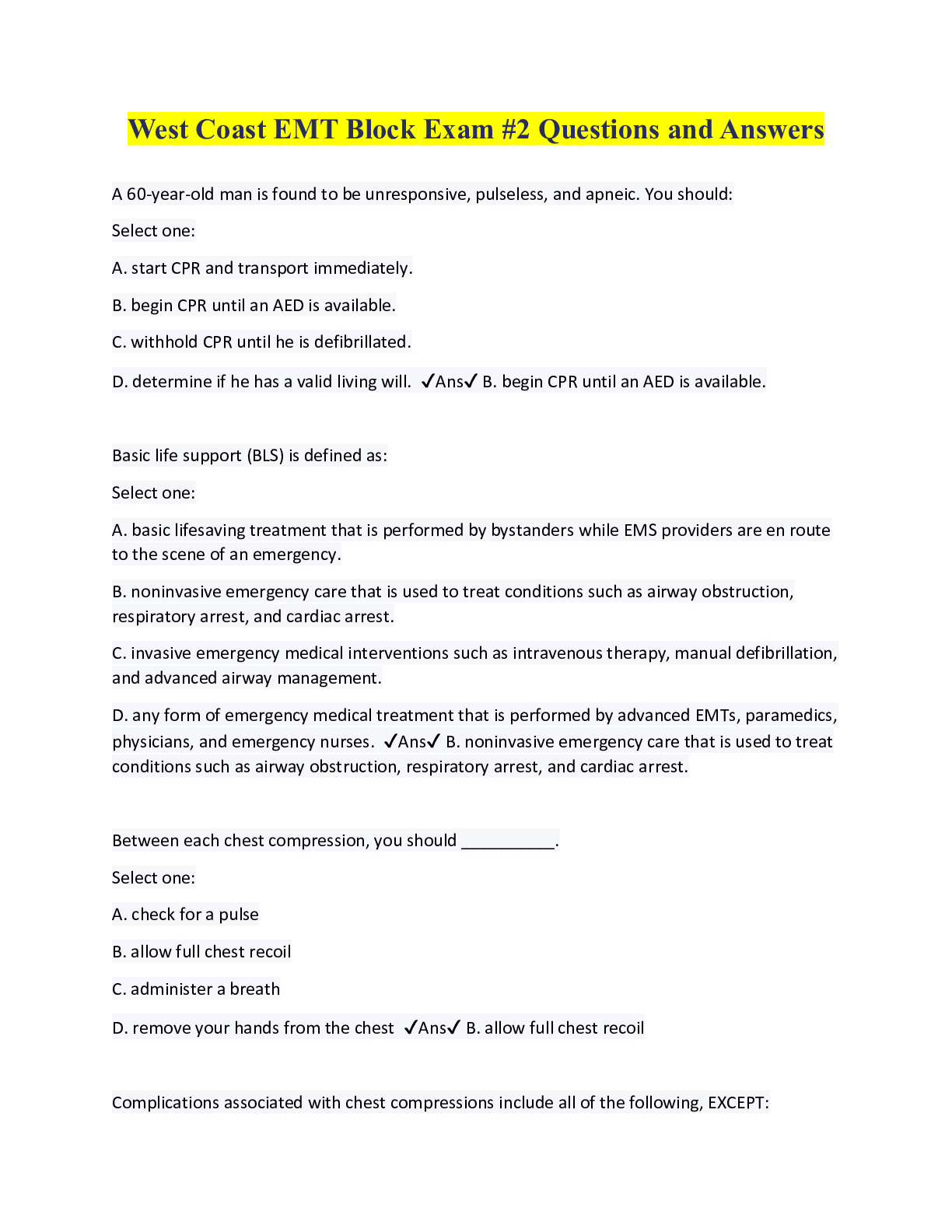
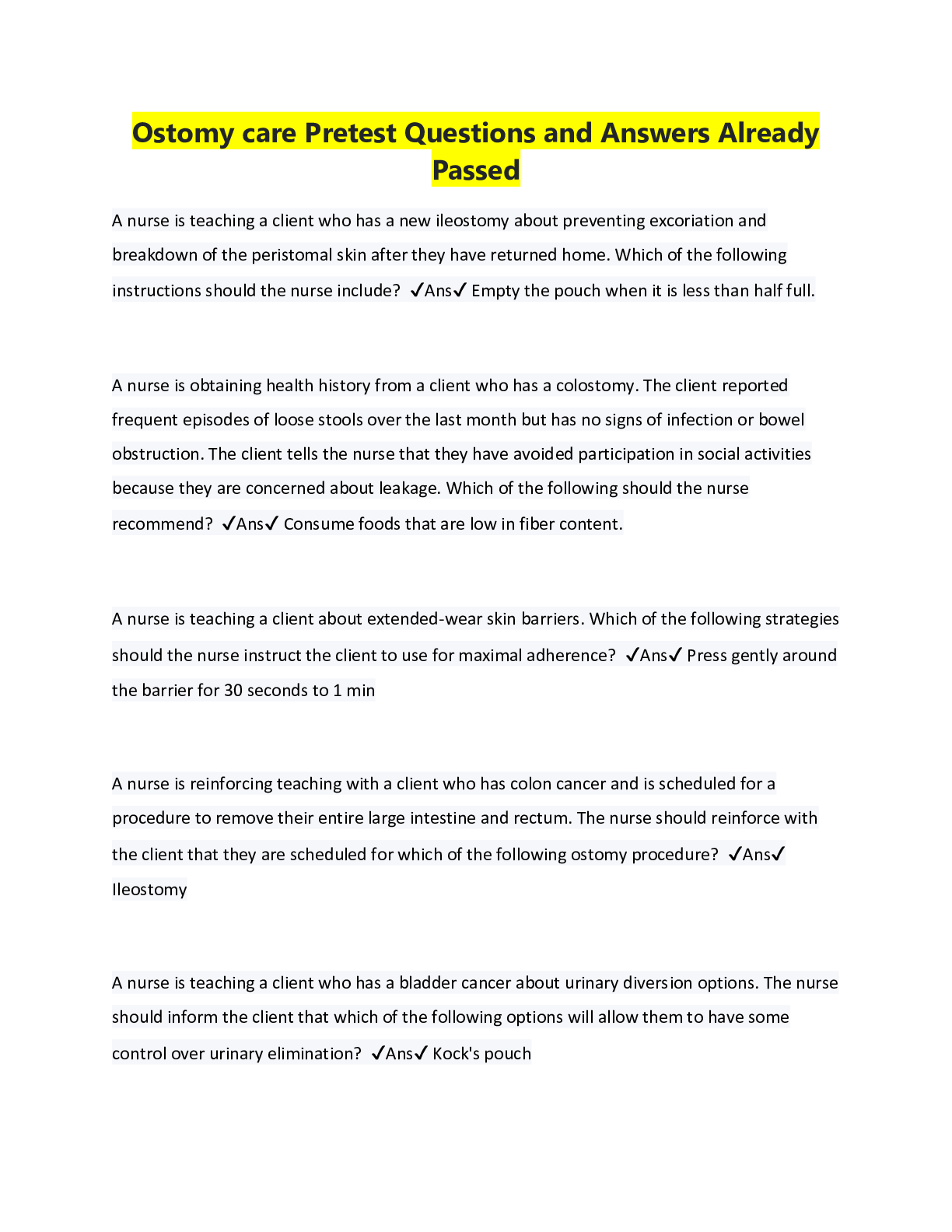
.png)
